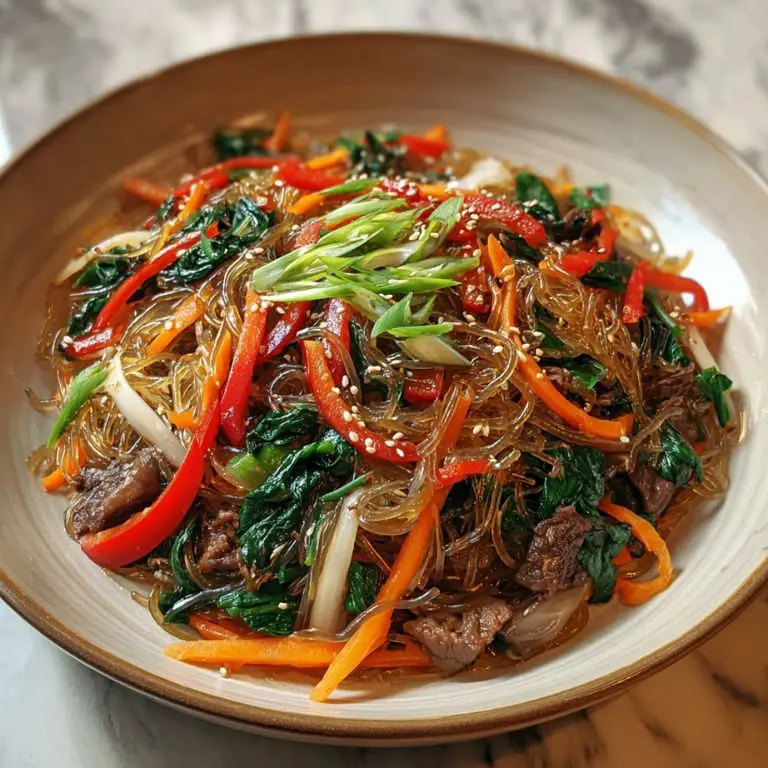There’s something incredibly comforting about a big pan of stir-fried noodles loaded with vibrant vegetables, savory-sweet sauce, and tender bites of beef. One-pan japchae brings all that joy and flavor with none of the juggling multiple pots and pans. Whether you’re just dipping your toes into Korean meals or looking to add an easy favorite to your weeknight rotation, this one-pan japchae recipe Korean style is a game changer. It’s hearty enough to be a main dish but works just as well as a Korean banchan recipe (side dish). And since it all comes together in one pan, cleanup is minimal — which makes it even more appealing for busy evenings.
One-Pan Japchae
Prep Time 15 minutes mins
Cook Time 20 minutes mins
Total Time 35 minutes mins
Course Main Course, Side Dish
Cuisine Korean
Large nonstick skillet or wok Ideally 12 inches or larger to accommodate all the ingredients without overcrowding. A cast iron skillet can also work.
Mixing bowls For tossing the sauce and prepping your beef.
Tongs or a wooden spoon To stir-fry and toss the noodles evenly.
Colander or sieve To drain and rinse your glass noodles after boiling.
Alternatives If you don’t have a wok, any wide, deep frying pan will do. And if you’re missing a colander, a slotted spoon can help remove the noodles from the boiling water.
For the Sauce
- 3 tablespoons soy sauce regular or low-sodium
- 1 tablespoon sesame oil
- 1 tablespoon brown sugar
- 1 teaspoon rice vinegar
- 1 teaspoon minced garlic
- 1/2 teaspoon freshly ground black pepper
For the Japchae
- 6 oz about half a package Korean glass noodles (dangmyeon)
- 1 tablespoon neutral oil like canola or vegetable oil
- 1/2 lb beef sirloin or ribeye thinly sliced against the grain
- 1 medium carrot julienned
- 1 small red bell pepper thinly sliced
- 1 small yellow onion thinly sliced
- 2 scallions sliced into 2-inch pieces
- 2 cups baby spinach
- 4 –5 shiitake mushrooms rehydrated if dried, sliced thin
- 1 tablespoon sesame seeds
- Salt to taste
Soak and Boil the Noodles
Start by soaking your Korean glass noodles in warm water for about 10 minutes. While they soak, you can prep your vegetables and slice your beef. After soaking, boil the noodles for 6–7 minutes until soft and chewy. Drain and rinse them under cold water to stop the cooking process. Set them aside.
Make the Sauce
In a small bowl, combine soy sauce, sesame oil, brown sugar, rice vinegar, garlic, and black pepper. Whisk until the sugar dissolves and set aside.
Sear the Beef
Heat your skillet over medium-high heat and add the oil. Toss in the sliced beef and sear until browned but not overcooked — about 2–3 minutes. Remove the beef and set it aside.
Cook the Vegetables
In the same pan, sauté the onions, carrots, and bell peppers for 2–3 minutes until just starting to soften. Add the mushrooms and cook for another minute. Then toss in the spinach and scallions, stirring just until wilted.
Combine Everything in the Pan
Add the cooked noodles and beef back into the pan. Pour the sauce over everything. Use tongs or a wooden spoon to toss and combine thoroughly, letting the sauce coat every strand of noodle and bit of vegetable. Cook for 2–3 more minutes, allowing everything to warm through and slightly caramelize.
Finish and Serve
Sprinkle with sesame seeds and give the japchae a final toss. Serve warm as a main dish or as one of several Korean side dishes. Leftovers reheat beautifully for lunch the next day.
Pairings
Japchae is versatile and fits in seamlessly with many Korean recipes easy enough for home cooks. If you’re serving this dish as part of a larger spread, consider adding:
- Kimchi: The fermented tangy bite balances the sweet-savory noodles perfectly.
- Grilled Galbi or Bulgogi: For meat lovers, adding a protein-packed grilled meat dish makes this a hearty meal.
- Cucumber Salad (Oi Muchim): A refreshing and spicy salad to cut through the richness.
- Steamed Rice: While japchae has noodles, rice is often served in traditional Korean meals alongside it.
- Korean Egg Rolls (Gyeran Mari): Another great banchan that complements the texture and flavor of japchae.
You could even make a Korean-inspired fusion plate by adding a side of Filipino food like lumpia or a spicy vinegar-based dip to bring another layer of flavor.
FAQs
1. What type of beef should I use for japchae?
Thinly sliced sirloin or ribeye is ideal. You want a tender cut that cooks quickly and doesn't become chewy. If you're on a budget, flank steak can also work if sliced against the grain and marinated briefly.
2. Can I make japchae vegetarian?
Absolutely! Simply omit the beef and double up on mushrooms or tofu for protein. This makes it one of the more flexible Korean noodle dishes out there.
3. What are Korean glass noodles made from?
They’re made from sweet potato starch and are naturally gluten-free. They're the star of any good japchae recipe Korean style — springy, chewy, and perfect for soaking up sauce.
4. Is japchae served hot or cold?
Japchae can be served warm, at room temperature, or even cold, making it an excellent dish for picnics or potlucks. For Chuseok food spreads, it’s often served room temp as a side.
5. Can I use other vegetables in japchae?
Yes! Bell peppers, spinach, carrots, and mushrooms are traditional, but you can also use zucchini, napa cabbage, or even kale. It’s one of the easiest Korean recipes to customize.
